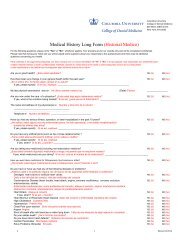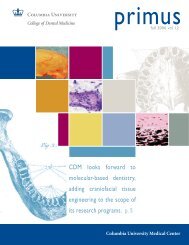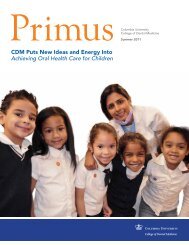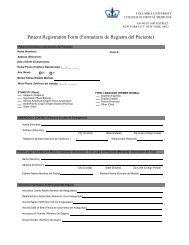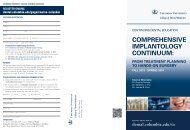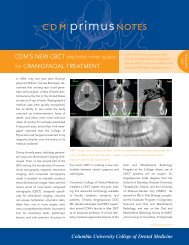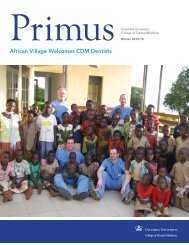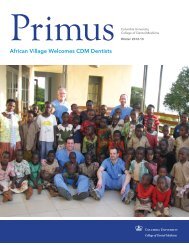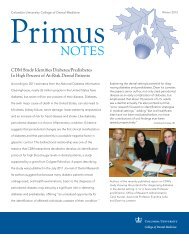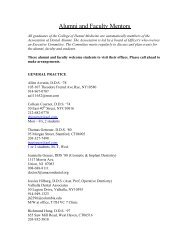Jarvie Journal - College of Dental Medicine - Columbia University
Jarvie Journal - College of Dental Medicine - Columbia University
Jarvie Journal - College of Dental Medicine - Columbia University
Create successful ePaper yourself
Turn your PDF publications into a flip-book with our unique Google optimized e-Paper software.
Volume 56, Spring 2013<br />
Effects <strong>of</strong> Estrogen on Mandibular Condylar Cartilage Growth and Proliferation<br />
Paola Annoni, Sunil Wadhwa, Jing Chen*<br />
<strong>College</strong> <strong>of</strong> <strong>Dental</strong> <strong>Medicine</strong>, <strong>Columbia</strong> <strong>University</strong>, NY, NY * Faculty Mentor<br />
Introduction:<br />
The mechanisms that regulate the development and differentiation <strong>of</strong> the mandibular condylar cartilage are<br />
intricate and currently not entirely understood. Estrogen plays a large role in regulating mandibular growth and<br />
differentiation. For example, ovariectomy (estrogen deficiency) causes increased growth <strong>of</strong> mandibular<br />
condylar cartilage that is reversed by estrogen supplementation. The mandibular cartilage is derived from the<br />
outer surface <strong>of</strong> the mandibular bone, called the periosteum. The chondrocytes specifically derive from the<br />
inner cambium layer <strong>of</strong> the periosteum, and then go on to proliferate into 4 chondral layers (superior articular [S<br />
layer], polymorphic + flattened [F layer], and hypertrophic [H layer]). There are two classical estrogen receptors<br />
here, and . Our central hypothesis is that estrogen acts through ER to inhibit chondrocyte maturation in the<br />
mandibular condylar cartilage in female mice.<br />
Objective:<br />
The objective <strong>of</strong> this study is to examine the role <strong>of</strong> estrogen via the ER pathway in regulating mandibular<br />
condylar growth in female WT and ER deficient mice. To achieve this aim, the mandibular condyle size along<br />
with the polymorphic cell growth and maturation from sham or ovariectomized WT and ER deficient female<br />
mice treated (or not treated) with estrogen has been analyzed and documented.<br />
Materials & Methods:<br />
Twenty-one day-old WT and ER deficient female mice were divided into three groups and sacrificed when<br />
they are 49 days old. The groups consisted <strong>of</strong>:<br />
1) Wild Type (sham), 2) Ovariectomy, 3) Ovariectomy+ Estrogen<br />
Once the mice were sacrificed, histological slides <strong>of</strong> their temporomandibular joints were made and the cells<br />
within the four chondral layers are then counted. In order to assess proliferation, BrdU immunohistochemistry<br />
was performed and the percentage <strong>of</strong> BrdU positive cells over total cell numbers was calculated.<br />
Results & Conclusions:<br />
We found that ovariectomy caused a significant increase in total cell numbers in the mandibular condylar<br />
cartilage that was reversed with estrogen supplementation in WT mice.<br />
On the other hand, ovariectomy plus estrogen replacement had no significant effects on female ER KO mice.<br />
Ovariectomy causes significant decrease in proliferation in both WT and ER KO compared to sham operated<br />
controls.<br />
Discussion:<br />
Previous studies have shown that ovariectomy causes a general increase in mandibular condylar cartilage size.<br />
In our study, we found similar results. However, when we performed ovariectomies on ER KO mice, no<br />
increase in condylar cartilage size was noted.<br />
Taken together, these results suggest that the effects <strong>of</strong> estrogen on condylar cartilage size are mainly mediated<br />
by ER receptor.<br />
Paola Annoni was supported by a <strong>College</strong> <strong>of</strong> <strong>Dental</strong> <strong>Medicine</strong> Pre-Doctor al Summer Research Fellowship.<br />
23



